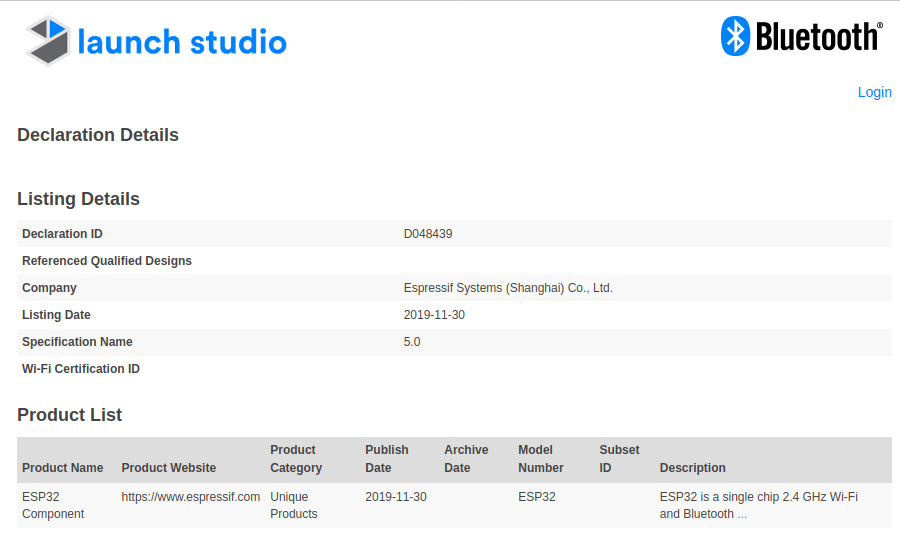Espressif Systems ESP32 was introduced in 2016, and one of the key differences between ESP8266 and ESP32 was that the latter supported Bluetooth 4.2.
But since then, the Bluetooth Special Interest Group (SIG) released Bluetooth 5.0 (2016) with higher speeds and longer range, and Bluetooth 5.1 (2019) adding direction finding for indoor positioning applications. One would have thought that upgrading from Bluetooth 4.2 to Bluetooth 5.0/5.1 might have required a new radio, but apparently not.
As you can see from the above link and screenshot, ESP32 is now Bluetooth LE 5.0-Certified having passed SIG Bluetooth LE 5.0 certification. That means the Bluetooth protocol version supported by the ESP32 microcontroller has been upgraded from Bluetooth LE 4.2 to Bluetooth LE 5.0 with improved stability and compatibility. Another link also shows Bluetooth 5.1 certification for ESP NimBLE Host stack.
Sadly that does not mean ESP32 suddenly supports the longer range and higher data rate made possible by Bluetooth 5.0 as explained in the announcement, as it would indeed require some hardware changes, and instead it’s really about improved compatibility.
ESP32 Bluetooth LE 5.0 certification means the software has been strengthened having passed a greater number of tests for the certifications. The Bluetooth LE Host protocol stack in ESP-IDF supports two types of Bluetooth LE Hosts: the aforementioned Bluetooth 5.1 certified NimBLE Host, as well as Bluedroid Host that should become Bluetooth LE 5.0 certified soon.

Jean-Luc started CNX Software in 2010 as a part-time endeavor, before quitting his job as a software engineering manager, and starting to write daily news, and reviews full time later in 2011.
Support CNX Software! Donate via cryptocurrencies, become a Patron on Patreon, or purchase goods on Amazon or Aliexpress





I think the longer range is possible to retrofit via sw only as the longer range is entirely based on processing gain, means better error coding with the on air 1mbps raw data rate reduced to 125k (for the payload only) to achieve the longer range.
When we look at the comparison for nRF52 chips: https://www.cnx-software.com/2017/08/09/nordic-semi-nrf52840-vs-nrf52832-vs-nrf52810-comparison-for-bluetooth-5-applications/, all support the higher bitrate and ADV, but only nRF52840 supports the longer range.
I think it might be a business strategy?
Yes, possible. I did not think about this, maybe I’m just too naive :).
We are technical people (so called engineers or tinkerers) so commercial stuff aleays plays a far inferior role in our point of view… I had to learn this the hard way, and still didn’t get it 😛
Others call this nativity 😉
Happy new year J-L!
you should also notice that nrf52832 supports 4dbm transmission while nrf52840 supports 8dbm 😉
That has nothing to do with the long range feature, but of course also increases range somewhat…
Cabn ESP32 support all Bluetooth Mesh specifications?
Probably if there’s a protocol stack supporting it…
Last time I checked, NimBLE was not compatible with WiFi co-existence. Also, I wonder how angle of arrival from Bluetooth 5.1 can be added on existing hardware.
AOA requires two antennas and an antenna switch between them which the ESP32 has. After that it is just software. This software needs access to the vector output of the antenna processing, something that is only accessible down inside the firmware. The further the antennas are apart, the better it works.
Thanks for the explanation. Do you know if AoA/AoD is mandatory in Bluetooth 5.1?
AOA is not mandatory. If the ESP were to implement I see now that it needs external hardware. You have to have an external antenna switch for this situation.
AOA can work from either side. The ESP32 does not need to implement it if the beacon implements it. There are some nice Nordic chips that implement it.